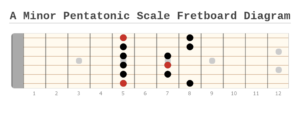It happens. We get curious. We daydream. What if I played piano too? Do I want to be a beginner again? What are the best second instruments for a guitarist? Why should you learn a second instrument?
First of all, learning your second instrument will be easier than your first. At least now you have a better idea of how music works. A second instrument can actually make you better at your first instrument. So whether you are just looking to improve your musicianship, be able to add to your band or want to be a more marketable musician – here are some suggestions.
1. Bass
Many guitarists have a dismissive attitude towards the bass. It only has four strings and you rarely play chords. But the truth is, guitarists do have some learning to become a good bass player. You know why Lynyrd Skynyrd had three guitarists? Because Ed King was so bad at bass, they asked him to switch to guitar so they could rehire their old bass player.
If you play lead guitar, your challenge will be trying to hold back. Nobody wants a lead bass player, especially the guitarist. The band depends on a steady bass player.
Why should you learn bass? Well, for one thing you will probably get a better appreciation for chord arpeggios. If you are playing some blues on bass, you’ll become the turnaround master. If you play in a band setting, you will see how important the drummer’s right foot is to the sound of the band. Also, get ready for some new calluses.
Pros
- Relatively easy to start
- Gives you a better understanding of song structure
- Bass players are in demand
Cons
- Bands only need one bass player
- Can be expensive – you need a new instrument and a new amp
2. Ukulele
The ukulele is more popular than ever. Perhaps it was Jake Shimabukuro’s incredible cover of “While My Guitar Gently Weeps” or a few appearances in pop songs recently, but the ukulele is everywhere. For good reason!
The ukulele is pretty easy to learn. There are less strings than a guitar and nylon strings are easier on the fingers than steel anyday! And let’s not forget the cost. You can get a decent ukulele for $50.
For a guitarist, it is really easy to pick up ukulele. Think of putting a capo on your fifth fret and just playing the top four strings. Your open D chord on guitar is a G chord on ukulele. A major difference is the reentrant tuning. The G string on the ukulele, which you would assume would be the lowest, is actually tuned an octave up. If it bothers you too much, you can string your uke with a low G string.
- Pros
- Very easy for a guitarist
- Currently popular
- Easy to travel
- Cons
- Limited uses
Guitar Vs. Ukulele
3. Harmonica
Like the ukulele, the harmonica is often treated like a toy. Even music stores will sometimes sell cheap ones at the counter. Sometimes they actually look like toys. But you only have to listen to some blues greats such as Little Walter, Junior Wells or James Cotton to know the harmonica is no toy. And then there is John Popper from Blues Traveler.
While individual harmonicas are not that expensive – 20 to 30 bucks – the problem is you will need one for every key you plan on playing. There are basically two types of harmonicas: diatonic and chromatic. The diatonic, generally the ones played in blues and rock, are tuned to a major scale. The chromatic can play all of the notes. These are the big, really cool looking harmonicas. Chromatics harmonicas are expensive and not easy to play.
When it comes to buying a diatonic harmonica you have to consider what type of tunes you will be playing. If you are going to play ala Neil Young and Bob Dylan, then you buy the key of the song. If you are playing some raw blues, you are going to play cross harp. Your harmonica is a fourth up from your tune. If the song is in the key of G, you buy a C harmonica.
There are challenges: you can’t see the instrument when you are playing, your tongue is working hard, and much of the learning is on your own. Also, harmonica players tend to be like guitarists when it comes to buying equipment. There are different brand harmonics, mics, amps and some even experiment with effects pedals.
- Pros
- Somewhat easy
- Low cost to entry
- Small instrument, easy to carry
- Cons
- Diatonic harmonicas require a different instrument for each key
- Harmonica players have bigger egos than guitar players
4. Mandolin
Of the strings instruments on this list, this is probably the furthest from the guitar. Mandolins have four sets of double strings. The pairs are tuned in unison. Mandolins strings are tuned fifths rather than fourths like the guitar, therefore your chords shapes are all different. Violins and mandolins are essentially the same instrument, one is fretless and played a bow while the other has frets and is played with a pick.
The mandolin has made multiple appearances in pop music through the years: Led Zeppelin, Rod Stewart and of course REM. Of course, mandolin is also a staple in bluegrass music and sometimes can be found in Irish music.
For the guitarist, a mandolin can be a nice switch in a set of music. It’s easy enough to learn but different enough to change the sound.
- Pros
- Relatively easy to learn
- Easy to switch in live performance
- Cons
- Limited genres
- Can be expensive
5. Piano/Keyboard
For the sake of consistency, we will just refer to the piano but in reality this could be any number of instruments: the organ, synthesizer, accordion, or even the melodica. It could be argued that the piano is the most important instrument to learn and while that may be true, it is also one of the hardest. A piano player is using both of their hands to play different parts of the song.
However, maybe you don’t have to become a great piano player to receive great benefit. If you are playing with a band, you don’t have to cover the chords with your left hand – just play with your right hand. If you are recording, use two piano tracks.
It is said Peter Townshend learned piano just to make him a better songwriter. Certainly, the Who’s songs from the seventies bear the fruits of Peter’s piano playing – even if he wasn’t playing the synths when performing live. How about Eddie Van Halen’s synth playing? Remember “Jump” – it’s almost all synth. Speaking of guys who played both in concert – how about Rush’s Geddy Lee?
The fact is, you may never get good enough for live performance but reap the benefits of what yourned on piano. A little midi keyboard, hooked up to a computer can allow use to access a vast amount of sound.
- Pros
- Great for understanding theory
- Can add a lot of depth to music
- Vast amount of learning sources
- Cons
- Hands are doing different things!
- Can be expensive
6. The Saxophone
Now for something real different! Yes, the saxophone. The only instrument that comes close to guitar in the coolness factor is the saxophone. While playing guitar does not give you much of a head start to learning sax, if you get good you will find your sax solos will get more attention than your best guitar solos.
If you ask a middle school band director, he will probably tell you the saxophone is the easiest horn to learn. A trumpet requires all kinds of technique in the mouth – called the embouchure – think about it, there are only three valves. A saxophone player, bites the mouthpiece, places her fingers and blows. Of course this is an oversimplification but you get the point. The challenge is your tone. And unlike guitar, your tone is as much to do with your mouth and throat as it is your equipment.
If you’re up for the challenge, keep in mind there are a few types of saxophones: soprano, alto, tenor, baritone and bass. If you’re gonna play some blues or rock, you want the tenor. There are student models and professional models. If you are going for a lower end professional tenor saxophone – be prepared to spend some money. I mean Les Paul levels of money!
- Pros
- Unique to many bands
- Not super hard, no chords!
- Quick switch in a gig
- Cool
- Cons
- Generally expensive
- Notes are easy, tone can take awhile to develop


